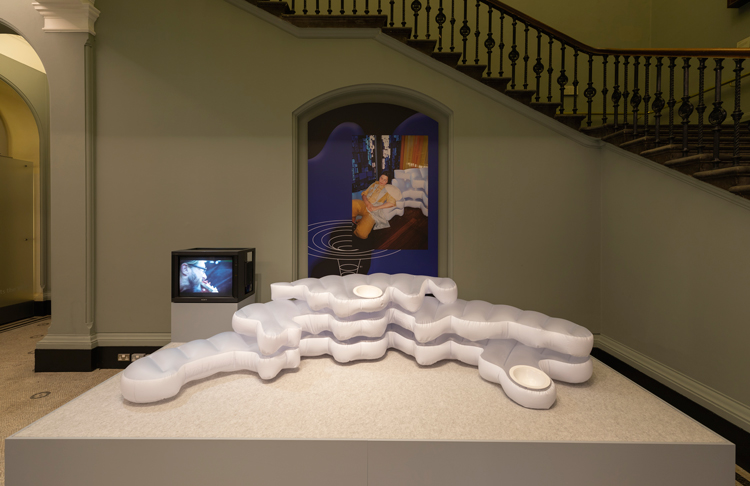A first look at the V&A’s installations for London Design Festival 2021
After a year off because of the pandemic, the museum is back with a slate of projects and installations for 2021 covering everything from climate change to AI.
The London Design Festival (LDF) is returning to the V&A with a series of 12 installations and projects, including one with no physical presence at all.
Because of the ongoing pandemic, the museum stepped back from its role as LDF’s “hub” in 2020. Announcing its return in an opening speech today, LDF co-founder and director Ben Evans stressed the intricate link between the festival and the V&A, saying it was “unlike any other relationship” in the cultural space.
This year’s installations largely tackle the broad themes of climate change and activism in different ways. Where some use very traditional methods, like model-making and brickwork, others use augmented reality and biomimicry.

“Visitors will have a shared experience even if they’re complete strangers”
For 2021’s landmark project in the Raphael Court, there isn’t much to see at first glance. US-based production studio Tin Drum and Japanese architect Sou Fujimoto’s Medusa promises an emotional collective experience, but not one you can see with the naked eye.
Visitors to the installation first must don a headset to see what’s happening. Once they do, the ceiling of the room becomes home to a striking suspended mixed reality structure.
The AR structure was built by the team at Fujimoto’s Japanese atelier, while the experience as a whole has been directed by Tin Drum’s Yoyo Munk. Munk says the main inspiration for the project was the interrelation between nature and art. “So often, our human structures come at the cost of natural structures,” he says, explaining that the form of Medusa is inspired by natural “structures” like the Aurora Borealis and bioluminescent fish.
More than just a chance to examine the relationship between nature and art however, he says Medusa is also about emotion. The mechanics of the installation mean that it reacts to the audience it is performing for. The structure will not appear in the same way for a group of five onlookers as it will for a group of 50. “This means each group of visitors will have a shared experience, even if they’re complete strangers,” Munk says.
As a piece of immaterial architecture, Munk explains that the usual things that determine the value of a structure have been stripped back – it doesn’t need to keep people safe, warm or dry. The only thing that’s left, he says, is to figure out how you feel about it.

“Character, romance and soul”
Beyond Medusa, the museum is also playing host to a slew of other projects. In the John Madejski Garden courtyard, emerging studio Nebbia Works has developed an immersive pavilion called “Between Forests and Skies”.
The metallic structure has been formed from the “lowest carbon aluminium the world has ever produced” according to its designers. The simple design means the least amount of material possible has been used – the structure is comprised only of sheet material and minimal cuts and bends.
Nebia co-founder Madhav Kidao says aluminium should be consider the “material of the future” because it is infinitely recyclable. But for him, Between Forests and Skies was principally a chance to take a material that is considered “industrial”, and turn it into something with “character, romance and soul”.

“The paradoxical nature in which we view microbes”
Back inside the building, and positioned below the National Art Library Staircase, sits another project this time designed by The Decorators. Portal Tables is a three-piece furniture collection which examines the paradoxical nature in which we view microbes.
The pandemic has served to vilify microbes, the studio says – but at the same time, lockdown saw an influx of baking and cooking practices that themselves use microbes to work. The Decorators’ three furniture pieces then are inflated objects which are designed to compliment the making of one of those foods.
The first is a small table, which can be used to make labneh, a type of cheese made with yoghurt. The second is a bulbous sofa featuring in-built proving bowls for breadmaking. The final and largest of the piece is what the studio calls the Kimchi Pool – as the name suggests, it is a large table which facilitates many people making the fermented food at once.

A fashion event “like never before”
In keeping with the museum’s extensive fashion collections, an installation from digital fashion company Auroboros sits in Room 40. Billed as a fashion event “like never before”, Biomimicry takes inspiration from the growth of a flower and will see a dress “grow and fall apart” over the course of the nine-day festival.
The gown will be worn by Ai-Da, the “world’s first ultra-realistic robot artist”. Ai-Da will be drawing and rendering the metamorphosis as it happens. Auroboros hopes the installation will provoke conversations around sustainability and ecological consciousness.
All of the V&A’s installations are housed at the museum’s Cromwell Road building, and are open during LDF from 18 to 26 September. For ticket bookings and more information, head to the V&A website or LDF website.
-
Post a comment





